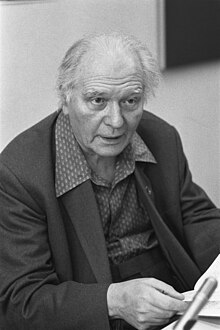
Back Olivier Messiaen Afrikaans أوليفييه مسيان Arabic اوليفييه مسيان ARZ Olivye Messian Azerbaijani Аліўе Месіян Byelorussian Оливие Месиен Bulgarian Olivier Messiaen Catalan Olivier Messiaen Czech Olivier Messiaen Welsh Olivier Messiaen Danish
Olivier Messiaen | |
|---|---|
 Messiaen in 1986 | |
| Born | 10 December 1908 Avignon, Third French Republic |
| Died | 27 April 1992 (aged 83) Clichy, France |
| Works | List of compositions |
| Spouses | |
Olivier Eugène Prosper Charles Messiaen (UK: /ˈmɛsiæ̃/,[1] US: /mɛˈsjæ̃, meɪˈsjæ̃, mɛˈsjɒ̃/;[2][3][4] French: [ɔlivje øʒɛn pʁɔspɛʁ ʃaʁl mɛsjɑ̃]; 10 December 1908 – 27 April 1992) was a French composer, organist, and ornithologist. One of the major composers of the 20th century, he was also an outstanding teacher of composition and musical analysis.
Messiaen entered the Paris Conservatoire at age 11 and studied with Paul Dukas, Maurice Emmanuel, Charles-Marie Widor and Marcel Dupré, among others. He was appointed organist at the Église de la Sainte-Trinité, Paris, in 1931, a post he held for 61 years, until his death. He taught at the Schola Cantorum de Paris during the 1930s. After the fall of France in 1940, Messiaen was interned for nine months in the German prisoner of war camp Stalag VIII-A, where he composed his Quatuor pour la fin du temps (Quartet for the End of Time) for the four instruments available in the prison—piano, violin, cello and clarinet. The piece was first performed by Messiaen and fellow prisoners for an audience of inmates and prison guards.[5] Soon after his release in 1941, Messiaen was appointed professor of harmony at the Paris Conservatoire. In 1966, he was appointed professor of composition there, and he held both positions until retiring in 1978. His many distinguished pupils included Iannis Xenakis, George Benjamin, Alexander Goehr, Pierre Boulez, Jacques Hétu, Tristan Murail, Karlheinz Stockhausen, György Kurtág, and Yvonne Loriod, who became his second wife.
Messiaen perceived colours when he heard certain musical chords (a phenomenon known as chromesthesia); according to him, combinations of these colours were important in his compositional process. He travelled widely and wrote works inspired by diverse influences, including Japanese music, the landscape of Bryce Canyon in Utah, and the life of St. Francis of Assisi. His style absorbed many global musical influences, such as Indonesian gamelan (tuned percussion often features prominently in his orchestral works). He found birdsong fascinating, notating bird songs worldwide and incorporating birdsong transcriptions into his music.
Messiaen's music is rhythmically complex. Harmonically and melodically, he employed a system he called modes of limited transposition, which he abstracted from the systems of material his early compositions and improvisations generated. He wrote music for chamber ensembles and orchestra, voice, solo organ, and piano, and experimented with the use of novel electronic instruments developed in Europe during his lifetime. For a short period he experimented with the parametrisation associated with "total serialism", in which field he is often cited as an innovator. His innovative use of colour, his conception of the relationship between time and music, and his use of birdsong are among the features that make Messiaen's music distinctive.
- ^ "Messiaen, Olivier". Lexico UK English Dictionary. Oxford University Press.[dead link]
- ^ "Messiaen". The American Heritage Dictionary of the English Language (5th ed.). HarperCollins. Retrieved 18 August 2019.
- ^ "Messiaen". Collins English Dictionary. HarperCollins. Retrieved 18 August 2019.
- ^ "Messiaen". Merriam-Webster.com Dictionary. Merriam-Webster. Retrieved 18 August 2019.
- ^ Cite error: The named reference
:0was invoked but never defined (see the help page).